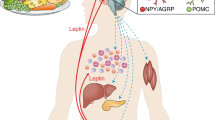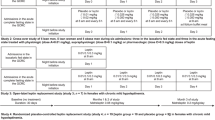Abstract
The discovery of leptin, the product of the ob gene, has led to major developments in understanding the regulation of energy balance. It is now recognised that leptin is produced in several organs additional to white adipose tissue, including brown fat, the placenta and fetal tissues (such as heart and bone\cartilage). The hormone has multiple functions—in inhibiting food intake, in the stimulation\maintenance of energy expenditure, as a signal to the reproductive system and as a ‘metabolic’ hormone influencing a range of processes (for example, insulin secretion, lipolysis, sugar transport). The production of leptin by white fat is subject to a number of regulatory influences, including insulin and glucocorticoids (which are stimulatory), and fasting and β-adrenoceptor agonists (which are inhibitory). A key role in the regulation of leptin production by white fat is envisaged for the sympathetic system, operating through β3-adrenoceptors. The leptin receptor gene is widely expressed, with the several splice variants exhibiting different patterns of expression. The long form variant (Ob-Rb) is expressed particularly in the hypothalamus, although it is being increasingly identified in other tissues. Leptin exerts its central effects through several neuroendocrine systems, including neuropeptide Y, glucagon-like peptide-1, melanocortins, corticotrophin releasing hormone (CRH) and cocaine- and amphetamine-regulated transcript (CART). In essence, the leptin system now appears highly complex, the hormone being involved in a range of physiological processes in a manner far transcending the initial lipostatic concept. This complexity may reduce the potential of the leptin system as a target for anti-obesity therapy.
This is a preview of subscription content, access via your institution
Access options
Subscribe to this journal
Receive 12 print issues and online access
$259.00 per year
only $21.58 per issue
Buy this article
- Purchase on Springer Link
- Instant access to full article PDF
Prices may be subject to local taxes which are calculated during checkout
Similar content being viewed by others
Author information
Authors and Affiliations
Rights and permissions
About this article
Cite this article
Trayhurn, P., Hoggard, N., Mercer, J. et al. Leptin: fundamental aspects. Int J Obes 23 (Suppl 1), S22–S28 (1999). https://doi.org/10.1038/sj.ijo.0800791
Published:
Issue Date:
DOI: https://doi.org/10.1038/sj.ijo.0800791
Keywords
This article is cited by
-
Effect of a high-fat diet and chromium on hormones level and Cr retention in rats
Journal of Endocrinological Investigation (2022)
-
Life in the fat lane: seasonal regulation of insulin sensitivity, food intake, and adipose biology in brown bears
Journal of Comparative Physiology B (2017)
-
Changes in plasma ghrelin and leptin levels in patients with peptic ulcer and gastritis following eradication of Helicobacter pylori infection
BMC Gastroenterology (2016)
-
Adipokines and biochemical changes in Egyptian obese subjects: possible variation with sex and degree of obesity
Endocrine (2015)
-
A proposed integrated systems approach to the radiation biology of cosmic interest: biophysics and molecular characterization of tissues irradiated with 14 MeV neutrons
Rendiconti Lincei (2014)



